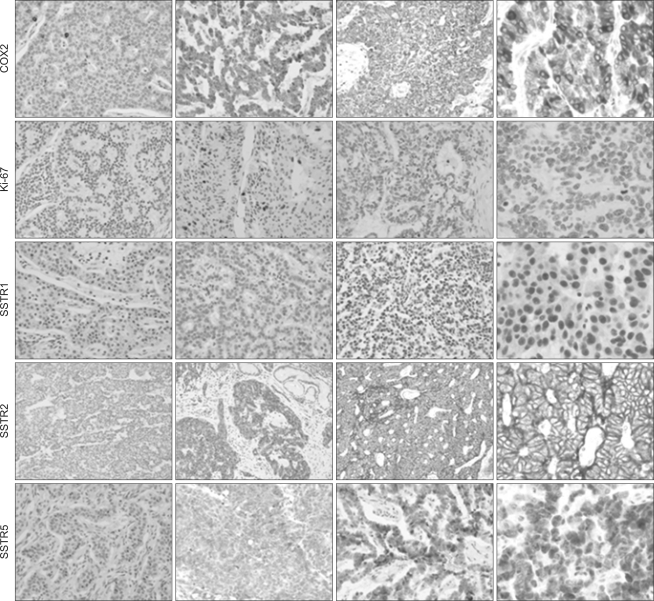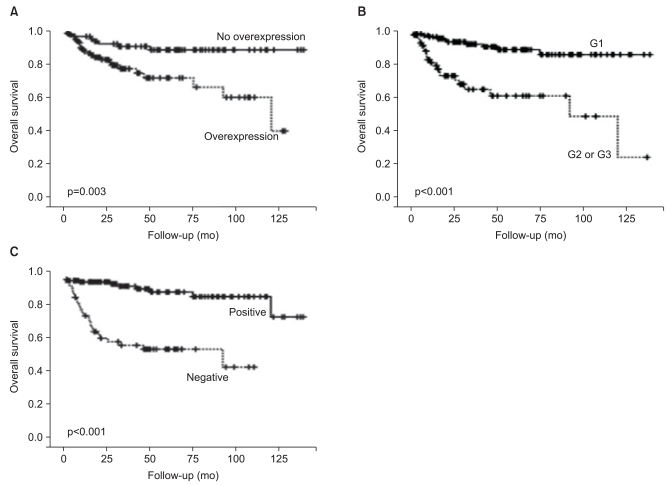Cancer Res Treat.
2011 Sep;43(3):181-188.
Clinical Significance of Protein Expression of Cyclooxygenase-2 and Somatostatin Receptors in Gastroenteropancreatic Neuroendocrine Tumors
- Affiliations
-
- 1Department of Pathology, KEPCO Medical Foundation, Hanil General Hospital, Seoul, Korea.
- 2Department of Pathology, Seoul National University Bundang Hospital, Seongnam, Korea.
- 3Department of Pathology, Seoul National University College of Medicine, Seoul, Korea. woohokim@snu.ac.kr
Abstract
- PURPOSE
This study was undertaken to evaluate the significance of cyclooxygenase-2 (COX2) overexpression and the expression of somatostatin receptor (SSTR) subtypes in gastroenteropancreatic neuroendocrine tumors (GEP-NETs).
MATERIALS AND METHODS
Two hundred and forty-seven cases of GEP-NET, comprising 86 foregut and 156 hindgut primary NETs, and 5 metastatic NETs in the liver, were studied retrospectively with immunohistochemistry for COX2, chromogranin A, Ki-67, SSTR1, SSTR2, and SSTR5.
RESULTS
COX2 overexpression was observed in 54%(126 of 234), and SSTR1, SSTR2, and SSTR5 positivity in 84%(196 of 233), 72%(168 of 233), and 55%(128 of 232), respectively. COX2 overexpression was found to be positively correlated with Ki-67 labeling index and inversely correlated with the expression of SSTR subtypes. In addition, the expression of SSTR subtypes was tightly correlated in any comparative pairs. A significant inverse correlation was found between COX2 and SSTR2 expression in the foregut, but not hindgut NETs. Kaplan-Meier analyses showed that COX2 overexpression (p=0.003) and high Ki-67 labeling index (p<0.001) were associated with poor overall survival (OS), whereas expression of SSTR2 (p<0.001) was associated with better OS of GEP-NET patients. Multivariate analysis revealed negative SSTR2 expression as an independent prognostic marker in GEP-NET patients (p<0.001).
CONCLUSION
Our results suggest that expression of SSTR subtypes is associated with favorable prognosis, whereas COX2 overexpression is associated with poor prognosis in GEP-NETs. Taken together, COX2 could be a possible therapeutic target in some subsets of GEP-NETs.
MeSH Terms
Figure
Reference
-
1. Oberg K, Eriksson B. Endocrine tumours of the pancreas. Best Pract Res Clin Gastroenterol. 2005; 19:753–781. PMID: 16253899.2. Plöckinger U, Rindi G, Arnold R, Eriksson B, Krenning EP, de Herder WW, et al. Guidelines for the diagnosis and treatment of neuroendocrine gastrointestinal tumours: a consensus statement on behalf of the European Neuroendocrine Tumour Society (ENETS). Neuroendocrinology. 2004; 80:394–424. PMID: 15838182.3. Nakajima T, Hamanaka K, Fukuda T, Oyama T, Kashiwabara K, Sano T. Why is cyclooxygenase-2 expressed in neuroendocrine cells of the human alimentary tract? Pathol Int. 1997; 47:889–891. PMID: 9503473.
Article4. Detjen KM, Welzel M, Wiedenmann B, Rosewicz S. Nonsteroidal anti-inflammatory drugs inhibit growth of human neuroendocrine tumor cells via G1 cell-cycle arrest. Int J Cancer. 2003; 107:844–853. PMID: 14566837.
Article5. Cadden I, Johnston BT, Turner G, McCance D, Ardill J, McGinty A. An evaluation of cyclooxygenase-2 as a prognostic biomarker in mid-gut carcinoid tumours. Neuroendocrinology. 2007; 86:104–111. PMID: 17700013.
Article6. Ohike N, Morohoshi T. Immunohistochemical analysis of cyclooxygenase (COX)-2 expression in pancreatic endocrine tumors: association with tumor progression and proliferation. Pathol Int. 2001; 51:770–777. PMID: 11881729.
Article7. Volante M, Bozzalla-Cassione F, Papotti M. Somatostatin receptors and their interest in diagnostic pathology. Endocr Pathol. 2004; 15:275–291. PMID: 15681851.
Article8. Eriksson B, Oberg K. Summing up 15 years of somatostatin analog therapy in neuroendocrine tumors: future outlook. Ann Oncol. 1999; 10(Suppl 2):S31–S38. PMID: 10399030.
Article9. Missiaglia E, Dalai I, Barbi S, Beghelli S, Falconi M, della Peruta M, et al. Pancreatic endocrine tumors: expression profiling evidences a role for AKT-mTOR pathway. J Clin Oncol. 2010; 28:245–255. PMID: 19917848.
Article10. Butturini G, Bettini R, Missiaglia E, Mantovani W, Dalai I, Capelli P, et al. Predictive factors of efficacy of the somatostatin analogue octreotide as first line therapy for advanced pancreatic endocrine carcinoma. Endocr Relat Cancer. 2006; 13:1213–1221. PMID: 17158766.
Article11. Greene FL, Page DL, Fleming ID, Fritz A, Balch CM, Haller DG, et al. AJCC cancer staging manual. 2002. 6th ed. New York, NY: Springer-Verlag.12. Solcia E, Klöppel G, Sobin LH. International histological classification of tumours. 2000. 2nd ed. Berlin: Springer-Verlag;p. 38–74.13. Kostopoulos I, Arapantoni-Dadioti P, Gogas H, Papadopoulos S, Malamou-Mitsi V, Scopa CD, et al. Evaluation of the prognostic value of HER-2 and VEGF in breast cancer patients participating in a randomized study with dose-dense sequential adjuvant chemotherapy. Breast Cancer Res Treat. 2006; 96:251–261. PMID: 16538542.
Article14. Ito T, Sasano H, Tanaka M, Osamura RY, Sasaki I, Kimura W, et al. Epidemiological study of gastroenteropancreatic neuroendocrine tumors in Japan. J Gastroenterol. 2010; 45:234–243. PMID: 20058030.
Article15. Okami J, Nakamori S, Yamamoto H, Sakon M, Tsujie M, Hayashi N, et al. An immunohistochemical study of cyclooxygenase (COX)-2 expression in endocrine tumors of the pancreas. J Exp Clin Cancer Res. 2002; 21:569–576. PMID: 12636104.16. Kwon KS, Chae HJ. Sodium salicylate inhibits expression of COX-2 through suppression of ERK and subsequent NF-kappaB activation in rat ventricular cardiomyocytes. Arch Pharm Res. 2003; 26:545–553. PMID: 12934647.17. Tang C, Liu C, Zhou X, Wang C. Enhanced inhibitive effects of combination of rofecoxib and octreotide on the growth of human gastric cancer. Int J Cancer. 2004; 112:470–474. PMID: 15382074.
Article18. Huang MT, Chen ZX, Wei B, Zhang B, Wang CH, Huang MH, et al. Preoperative growth inhibition of human gastric adenocarcinoma treated with a combination of celecoxib and octreotide. Acta Pharmacol Sin. 2007; 28:1842–1850. PMID: 17959037.
Article19. Rinke A, Müller HH, Schade-Brittinger C, Klose KJ, Barth P, Wied M, et al. Placebo-controlled, double-blind, prospective, randomized study on the effect of octreotide LAR in the control of tumor growth in patients with metastatic neuroendocrine midgut tumors: a report from the PROMID Study Group. J Clin Oncol. 2009; 27:4656–4663. PMID: 19704057.
Article20. Schally AV, Nagy A. Chemotherapy targeted to cancers through tumoral hormone receptors. Trends Endocrinol Metab. 2004; 15:300–310. PMID: 15350601.
Article21. Buscail L, Saint-Laurent N, Chastre E, Vaillant JC, Gespach C, Capella G, et al. Loss of sst2 somatostatin receptor gene expression in human pancreatic and colorectal cancer. Cancer Res. 1996; 56:1823–1827. PMID: 8620499.22. Slaby O, Sachlova M, Bednarikova M, Fabian P, Svoboda M, Vytopilova S, et al. Gene expression of somatostatin receptor 4 predicts clinical outcome of patients with metastatic neuroendocrine tumors treated with somatostatin analogs. Cancer Biother Radiopharm. 2010; 25:237–243. PMID: 20423238.
Article23. Taboada GF, Neto LV, Luque RM, Córdoba-Chacón J, de Oliveira Machado E, de Carvalho DP, et al. Impact of gsp oncogene on the mRNA content for somatostatin and dopamine receptors in human somatotropinomas. Neuroendocrinology. 2011; 93:40–47. PMID: 21079388.24. Papotti M, Bongiovanni M, Volante M, Allìa E, Landolfi S, Helboe L, et al. Expression of somatostatin receptor types 1-5 in 81 cases of gastrointestinal and pancreatic endocrine tumors. A correlative immunohistochemical and reverse-transcriptase polymerase chain reaction analysis. Virchows Arch. 2002; 440:461–475. PMID: 12021920.
- Full Text Links
- Actions
-
Cited
- CITED
-
- Close
- Share
- Similar articles
-
- Antitumor Effects of Somatostatin Analogs in Gastroenteropancreatic Neuroendocrine Tumors
- Somatostatin Receptor Scintigraphy
- SSTR2A Protein Expression in Neuroendocrine Neoplasms of the Colorectum
- Review of Radionuclide Treatment for Neuroendocrine Tumors
- Somatostatin Receptors in Lung Cancer: From Function to Molecular Imaging and Therapeutics



